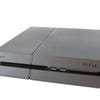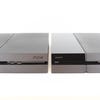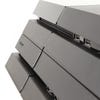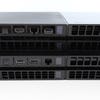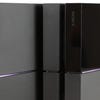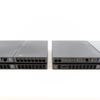PlayStation 4 CUH-1200 'C-Chassis' review
The new PS4 is a lot quieter and more power efficient, so should you upgrade?
After early first sightings in Japan, the new CUH-1200 series PlayStation 4 - or C-Chassis - is now starting to circulate UK stores. With little fanfare from Sony to mark its arrival, the console bears several noteworthy changes over earlier PS4 models. Its physical design gets some choice tweaks, but reports of lowered noise levels also point to it addressing one of the console's longest running bugbears. But is the improvement really that radical, and if so, is it worth upgrading if you've already committed to an earlier model?
Before we start, the new CUH-1200 C-Chassis model brings some curious physical changes. Gone is the PS4's glossy panel, and the new revision gives us a uniformly matte surface on top - a material less prone to dust and scratches build-up. Smart, depressible buttons also now feature at the front, with power and eject switches protruding by a millimetre. These give a satisfying, tactile click, replacing the last model's more sensitive capacitive buttons. Running down its centre is also a new LED assembly, a shorter strip of light that doesn't stretch as far across as the launch model's. Conversely, the new model's LED is brighter, and by comparison shows up better in daylight conditions.
Internally there's been some shifting around too. Rather than using 16 modules of 512mb GDDR5 RAM (tallying up the console's full 8GB of memory), we now have eight bigger clusters of 1GB. As a consequence of halving the modules, space is freed up on the opposite side of the motherboard, and energy efficiency should be greatly improved as a result - something borne out in our later tests. Added to this, we have a slightly thicker 500GB HDD in the new console - a Samsung Spinpoint drive that's swapped from the thinner HGST drive in our original PS4. The PS4's power supply unit is also replaced with a lighter, lower output model, in part contributing to the C-Chassis' lower 2.5kg weight - 300g lighter than the launch model.
Otherwise, the new PS4 is in many ways similar to the old. Placed side-by-side, the dimensions are matched to the millimeter (barring the new buttons), while internally, shots reveal the same sized APU at the motherboard's centre - a likewise 28nm chip. The only other tweak is to the PS4's port layout around the back; the HDMI, auxiliary and Ethernet ports all switched around at no real consequence.
But what of the PS4's noise levels? It's fair to say that fan speeds on our launch model ratchet up to a distracting degree during play, especially so with games like The Last of Us Remastered. One of the worst offenders as of late is Rocket League - an Unreal Engine 3 game that cranks the older CUH-1000 PS4 up to 63.7 decibels (dB) on our sound meter (as tested while upright on a wooden desk, and viewing a 4v4 match in spectator mode). Our sensor takes its reading from a centimetre behind the console's back vents, recording the fan at its top-most RPM - and it's fair to say that the high-pitched whine is a distraction even from a few metres away.
By comparison, the C-Chassis PS4 makes a real difference. In starting the console under the exact same testing conditions, Rocket League doesn't rise much higher than 51.2 decibels on the meter. This puts the new PS4 model at 12 decibels quieter overall in this close-proximity test. Though we're unlikely to get so close to a PS4 vents in reality, the difference is tangible at a regular playing distance from the console. At full speed, the launch PS4 is audible from across our office - a louder presence with higher pitch and volume. The new model is far from whisper quiet, but the fan isn't nearly such a distraction at max velocity.
It's a big improvement, and one that holds up in other tests. For example, our disc-based version of Metal Gear Solid 5 starts off loud on each PS4 as the optical drive initially caches data to the HDD, but this ceases after five minutes of play. Once settled, the C-Chassis gives a six decibel lead over the launch PS4 here, from 62.2 dB down to 56.2.
| PlayStation 4 Max Power/Noise (Watts/Decibels) | CUH-1000 Peak Power (Watts) | CUH-1200 Peak Power (Watts) | CUH-1000 Noise (Decibels) | CUH-1200 Noise (Decibels) |
|---|---|---|---|---|
| Standby | 1.0 | 1.0 | 40.6 | 40.6 |
| Rest Mode | 6.9 | 6.8 | 41.4 | 40.8 |
| PS4 Front-End (Online) | 80.1 | 65.6 | 44.0 | 42.2 |
| Rocket League 4v4 on Mannsfield | 146 | 116 | 63.7 | 51.2 |
| AC Unity Title Screen (disc spinning) | 130 | 112 | 64.5 | 55.2 |
| Metal Gear Solid 5 Mission 1 (no disc spinning) | 133 | 106 | 62.2 | 56.5 |
But what of games with longer initial installs from disc - adding to the noise output? Assassin's Creed Unity caught our attention last year, with even its menu screen ramping up the decibels to 64.5 on our launch unit. Surprisingly, the C-Chassis undercuts this by around ten decibels once again - at 55.2 - despite the disc drive adding turbulence. Again, the advantage is clear, and in practice it's a much quieter machine.
Power efficiency is also improved on the C-Chassis PS4. In testing both units with a power meter at the mains, we take the peak throughput from each - making sure to keep background services (such as downloads) disabled. The result: the new PS4 is 30W more power efficient in games such as Metal Gear Solid 5 (with no disc spinning), and Rocket League. The latter is surprisingly the most power-hungry test here, dropping from 146W to just 116W - a big saving.
We see healthy gains on the PS4's front-end menu too, shaving 15W off the launch model's 80W reading. Sadly, disc-based games demand a constant level of power from both consoles, a charge needed by the optical drive as it seeks data from the disc. In Assassin's Creed Unity, the gain is restricted to 18W as a result, though it's still a very decent saving overall for the C-Chassis PS4.
There is a downside to this new PS4 design though. While the lowered noise level is an obvious plus, dropping the C-Chassis' fan speeds ultimately has a negative impact on its thermals. After all, the casing and airflow constructs are much the same as before, and given the heat stems from a matching 28nm APU, this inevitably leads to a hotter console. With a thermal camera locked on, we see Rocket League ramping the PS4's casing to a peak of 45.5 degrees Celsius at this central point.
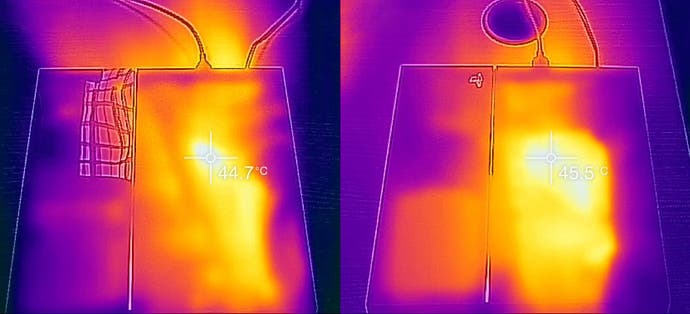
| PlayStation 4 Max Chassis Heat | CUH-1000 (Celsius) | CUH-1200 (Celsius) |
|---|---|---|
| Rest Mode | 27.0 | 30.0 |
| PS4 Front-End (Offline) | 35.7 | 38.0 |
| PS4 Front-End (Online) | 37.0 | 39.0 |
| Rocket League In-Game | 44.7 | 45.5 |
It's a step back from the launch model, where higher fan speeds keep the unit at a stubborn peak of 44.7 degrees Celsius. It's a similar state of affairs in the PS4 menus, where either online or off, we see a two degree delta in favour of the older PS4 (37 degrees while online, versus the C-Chassis' consistent 39). Looking at the heat maps of both PS4 units, it's apparent why; the spread of heat is more evenly spread on the launch model - with vents around the back billowing much more of this heat onto the table behind.
As for the C-Chassis model, the hot air isn't dispersed so aggressively, meaning it concentrates on the focal point: the APU at the centre. Fortunately, this is only a two degree difference, which shouldn't impact the console's reliability. These metrics show a degree of caution from Sony's engineers - no doubt keen to avoid the overheating issues of last-gen machines, Given enough space to ventilate at the back, the new PS4 model's thermals are well accounted for, and crucially, with a fan speed that doesn't overwhelm.
PlayStation 4 CUH-1200 'C-Chassis': the Digital Foundry verdict
Two years into its lifespan, the new C-Chassis model PS4 tackles the hardware's most glaring issue: its acoustic signature under load. In terms of noise output, the fans still kick into a high gear with games like Rocket League - and just like the launch PS4, a disc spinning in the drive pushes this decibel reading still higher. However, it's without a doubt a substantial improvement over the launch unit. The heavier rush of air in our CUH-1000 model is replaced with a more bearable hum, at 10dB quieter; a sound that's no longer audible from across an office space. For all intents and purposes, the most grating edge of the PS4's audio signature is taken off.
It's quieter, lighter and around 30W more power efficient during the games tested. But as a sacrifice, peak temperatures are also marginally worse. Given that its APU uses the same 28nm design as a launch PS4, inevitably the C-Chassis' drop in fan speed has a knock-on effect with heat build-up inside the unit. Fortunately, this rarely exceeds the last model by much more than two degrees Celsius overall, which gives an optimistic outlook on the new console's long-term reliability. It's a minor detracting point, and on balance for the improved acoustics, a worthy trade-off.
The move to a full matte finish, a revised LED strip up top, and the use of physical 'clicky' buttons for power and eject are all subtle, but welcome changes too. However, the focus is really on the new PS4 model's curtailed noise and power levels, with most other aspects fixed in place. Is an upgrade from a launch unit justifiable here? We would suggest no; the C-Chassis is a clear advance in the PS4's design, but at the console's circa £260 price-point it makes more sense to hang tight for a more radical revision down the line. But for those making a first investment on a PS4 soon, the CUH-1200 is without doubt the one to buy.



